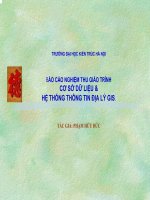3 xử lý tập TIN, lưu TRẠNG THÁI ỨNG DỤNG, THAO tác cơ sở dữ LIỆU và CONTENT PROVIDER
Bạn đang xem bản rút gọn của tài liệu. Xem và tải ngay bản đầy đủ của tài liệu tại đây (2.82 MB, 98 trang )
DONG NAI UNIVERSITY OF TECHNOLOGY
1. Files
2. XML Parser
3. Shared Preferences
4. SQLite
5. Content Provider
1
DONG NAI UNIVERSITY OF TECHNOLOGY
Android Files
Uses the same file constructions found in a
typical Java application
Files can be stored in the device’s (small) main
memory or in the much larger SD card.
Files stored in the device’s memory, stay together
with other application’s resources (such as icons,
pictures, music, ). We will call this type: Resource
Files.
2
DONG NAI UNIVERSITY OF TECHNOLOGY
Data storage options
Shared Preferences Store private primitive data
in key-value pairs.
Internal Storage Store private data on the
device’s memory.
External Storage Store public data on the shared
external storage.
SQLite Databases Store structured data in a
private/public database.
Network Connection Store data on the web with
your own network server.
3
DONG NAI UNIVERSITY OF TECHNOLOGY
1. Files
1.1 Internal Storage
1.2 External Storage
1.3 Saving Cache files
4
DONG NAI UNIVERSITY OF TECHNOLOGY
1.1 Internal Storage
Reading Resource File : Everything in the apk will be read only.
And it's even better: android doesn't extract the apk when you
install a program, so the size consumed is kept to minimal.
5
DONG NAI UNIVERSITY OF TECHNOLOGY
1.1 Internal Storage
Reading Resource File
6
DONG NAI UNIVERSITY OF TECHNOLOGY
1.1 Internal Storage
If you want to Read and Write an internal file:
File is stored in the phone’s memory under:
/data/data/app/files
7
DONG NAI UNIVERSITY OF TECHNOLOGY
1.1 Internal Storage
Reading an internal File
8
DONG NAI UNIVERSITY OF TECHNOLOGY
1.1 Internal Storage
Writing an internal File
9
DONG NAI UNIVERSITY OF TECHNOLOGY
1.2 External Storage
Reading/Writing to External Device’s SD card. SD card
has the obvious advantage of a larger working space.
10
DONG NAI UNIVERSITY OF TECHNOLOGY
1.2 External Storage
Reading
11
DONG NAI UNIVERSITY OF TECHNOLOGY
1.2 External Storage
Writing
12
DONG NAI UNIVERSITY OF TECHNOLOGY
1.3 Saving Cache files
To speed up your application’s performance and how often it
accesses the networkcreate a cache file.
Cache files are stored in the following location on the Android
file system: /data/data/app/cache
Click icon to
pull or push file
13
DONG NAI UNIVERSITY OF TECHNOLOGY
1.3 Saving Cache files
If you'd like to cache some data, rather than store it
persistently, you should use getCacheDir() to open a File
that represents the internal directory where your
application should save temporary cache files.
When the device is low on internal storage space,
Android may delete these cache files to recover space.
However, you should not rely on the system to clean up
these files for you. You should always maintain the cache
files yourself and stay within a reasonable limit of space
consumed, such as 1MB. When the user uninstalls your
application, these files are removed.
14
DONG NAI UNIVERSITY OF TECHNOLOGY
1.3 Saving Cache files
Creating cache file
15
DONG NAI UNIVERSITY OF TECHNOLOGY
1.3 Saving Cache files
Reading cache file
16
DONG NAI UNIVERSITY OF TECHNOLOGY
1.3 Saving Cache files
Get all cache files
17
DONG NAI UNIVERSITY OF TECHNOLOGY
2. XML Parser
2.1 What’s XML?
2.2 How is XML used?
2.3 Parsing XML by DOM
2.4 Parsing XML by SAX
18
DONG NAI UNIVERSITY OF TECHNOLOGY
2.1 What’s XML?
Extensible Markup Language (XML) is a set of rules for
encoding documents in a readable form.
Similar to HTML but <tagElements> are user-defined.
It is defined in the XML Specification produced by the W3C.
XML's design goals emphasize transparency, simplicity, and
transportability over the Internet.
Example of XML-based languages include: RSS , Atom,
SOAP, and XHTML.
Several office productivity tools default to XML format for
internal data storage. Example: Microsoft Office,
OpenOffice.org, and Apple's iWork.
19
DONG NAI UNIVERSITY OF TECHNOLOGY
2.2 How is XML used?
XML is used for defining and documenting object classes.
For example, an XML document (.xml) might contain a
collection of complex employee elements, such as
<employee id=“…” title=“…” >...</employee> which
lexically includes an “id” and “title” attributes.
Employee may also hold other inner elements such as
“name”, “country”, “city”, and “zip”.
An XML-Data schema (.xsd) can describe such syntax.
20
DONG NAI UNIVERSITY OF TECHNOLOGY
2.2 How is XML used?
21
DONG NAI UNIVERSITY OF TECHNOLOGY
2.3 Parsing XML by DOM
DOM : W3C DocumentBuilder Parser
Document Object Model
Cache all
Standard tree structure
Parsing this XML
22
DONG NAI UNIVERSITY OF TECHNOLOGY
2.3 Parsing XML by DOM
The XML file is given to the W3C parser to construct an
equivalent tree.
Elements from the XML file are represented in the parsetree as NodeLists. These ArrayList-like collections are made
with the .getElementsByTagName() method.
An individual node from a NodeList could be explored using
the methods:
.item(i), .getName() , .getValue() , .getFirstChild() ,
.getAttributes(),…
23
DONG NAI UNIVERSITY OF TECHNOLOGY
2.3 Parsing XML by DOM
Creating
a Java DOM XML parser is done using the
javax.xml.parsers.DocumentBuilderFactory class.
Parsing an XML file into a DOM tree
24
DONG NAI UNIVERSITY OF TECHNOLOGY
2.3 Parsing XML by DOM
25









